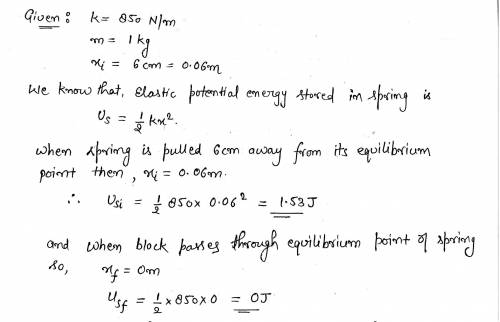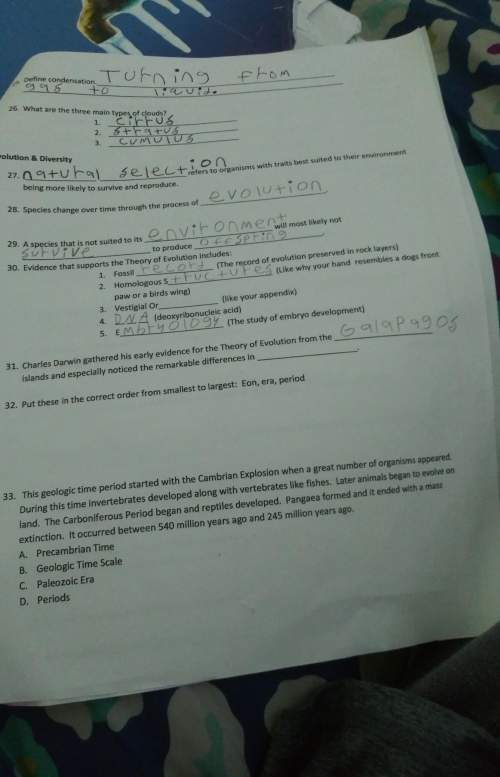
Physics, 14.05.2021 17:40 MrKrinkle77
A horizontal spring attached to a wall has a force constant of 850 N/m. A block of mass 1.00 kg is attached to the spring and oscillates freely on a horizontal, frictionless surface as in Active Figure 5.20. The initial goal of this problem is to find the velocity at the equilibrium point after the block is released. (a) What objects constitute the system, and through what forces do they interact? (b) What are the two points of interest? (c) Find the energy stored in the spring when the mass is stretched 6.00 cm from equilibrium and again when the mass passes through equilibrium after being released from rest. (d) Write the conservation of energy equation for this situation and solve it for the speed of the mass as it passes equilibrium. Substitute to obtain a numerical value. (e) What is the speed at the halfway point? Why isn’t it half the speed at equilibrium

Answers: 1
Another question on Physics

Physics, 22.06.2019 01:30
In a thunderstorm, charge builds up on the water droplets or ice crystals in a cloud. thus, the charge can be considered to be distributed uniformly throughout the cloud. for the purposes of this problem, take the cloud to be a sphere of diameter 1.00 kilometer. the point of this problem is to estimate the maximum amount of charge that this cloud can contain, assuming that the charge builds up until the electric field at the surface of the cloud reaches the value at which the surrounding air breaks down. this breakdown means that the air becomes highly ionized, enabling it to conduct the charge from the cloud to the ground or another nearby cloud. the ionized air will then emit light due to the recombination of the electrons and atoms to form excited molecules that radiate light. in addition, the large current will heat up the air, resulting in its rapid expansion. these two phenomena account for the appearance of lightning and the sound of thunder. take the breakdown electric field of air to be eb=3.00ă—106n/c. part a estimate the total charge q on the cloud when the breakdown of the surrounding air is reached. express your answer numerically, to three significant figures, using ďµ0=8.85ă—10â’12c2/(nâ‹…m2) .
Answers: 2

Physics, 22.06.2019 13:00
4. if you were an astronaut on the moon, what would you experience? what would you see from your perspective?
Answers: 1

Physics, 22.06.2019 14:40
The experiment done in lab is repeated, using a ball that has unknown mass m. you plot your data in the form of f 2 versus m/l, with f in rev/s, m in kg, and l in m. your data falls close to a straight line that has slope 3.19 m/(kg · s2). use g = 9.80 m/s2 and calculate the mass m of the ball.
Answers: 1

Physics, 22.06.2019 17:30
Four point charges each having charge q are located at the corners of a square having sides of length a. find symbolic expressions for the following. (a) the total electric potential at the center of the square due to the four charges (use any variable or symbol stated above along with the following as necessary: ke.) vtotal= (b) the work required to bring a fifth charge p from infinity to the center of the square (use any variable or symbol stated above along with the following as necessary: w=
Answers: 2
You know the right answer?
A horizontal spring attached to a wall has a force constant of 850 N/m. A block of mass 1.00 kg is a...
Questions

Physics, 17.10.2019 12:10

Mathematics, 17.10.2019 12:10

Mathematics, 17.10.2019 12:10

English, 17.10.2019 12:10

History, 17.10.2019 12:10


Mathematics, 17.10.2019 12:10

Mathematics, 17.10.2019 12:10



History, 17.10.2019 12:10

Biology, 17.10.2019 12:10


Chemistry, 17.10.2019 12:10

Mathematics, 17.10.2019 12:10

Physics, 17.10.2019 12:10




History, 17.10.2019 12:10







